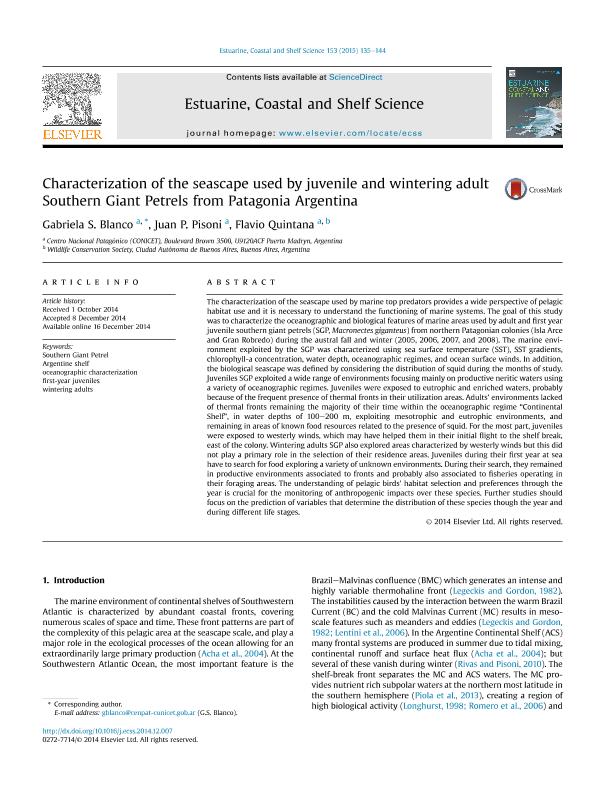Mostrar el registro sencillo del ítem
dc.contributor.author
Blanco, Gabriela Silvina

dc.contributor.author
Pisoni, Juan Pablo

dc.contributor.author
Quintana, Flavio Roberto

dc.date.available
2017-07-17T21:17:47Z
dc.date.issued
2014-12-16
dc.identifier.citation
Blanco, Gabriela Silvina; Pisoni, Juan Pablo; Quintana, Flavio Roberto; Characterization of the seascape used by juvenile and wintering adult Southern Giant Petrels from Patagonia Argentina; Elsevier; Estuarine, Coastal and Shelf Science; 153; 16-12-2014; 135-144
dc.identifier.issn
0272-7714
dc.identifier.uri
http://hdl.handle.net/11336/20765
dc.description.abstract
The characterization of the seascape used by marine top predators provides a wide perspective of pelagic habitat use and it is necessary to understand the functioning of marine systems. The goal of this study was to characterize the oceanographic and biological features of marine areas used by adult and first year juvenile southern giant petrels (SGP, Macronectes giganteus) from northern Patagonian colonies (Isla Arce and Gran Robredo) during the austral fall and winter (2005, 2006, 2007, and 2008). The marine environment exploited by the SGP was characterized using sea surface temperature (SST), SST gradients, chlorophyll-a concentration, water depth, oceanographic regimes, and ocean surface winds. In addition, the biological seascape was defined by considering the distribution of squid during the months of study. Juveniles SGP exploited a wide range of environments focusing mainly on productive neritic waters using a variety of oceanographic regimes. Juveniles were exposed to eutrophic and enriched waters, probably because of the frequent presence of thermal fronts in their utilization areas. Adults´ environments lacked of thermal fronts remaining the majority of their time within the oceanographic regime "Continental Shelf", in water depths of 100-200 m, exploiting mesotrophic and eutrophic environments, and remaining in areas of known food resources related to the presence of squid. For the most part, juveniles were exposed to westerly winds, which may have helped them in their initial flight to the shelf break, east of the colony. Wintering adults SGP also explored areas characterized by westerly winds but this did not play a primary role in the selection of their residence areas. Juveniles during their first year at sea have to search for food exploring a variety of unknown environments. During their search, they remained in productive environments associated to fronts and probably also associated to fisheries operating in their foraging areas. The understanding of pelagic birds´ habitat selection and preferences through the year is crucial for the monitoring of anthropogenic impacts over these species. Further studies should focus on the prediction of variables that determine the distribution of these species though the year and during different life stages.
dc.format
application/pdf
dc.language.iso
eng
dc.publisher
Elsevier

dc.rights
info:eu-repo/semantics/openAccess
dc.rights.uri
https://creativecommons.org/licenses/by-nc-sa/2.5/ar/
dc.subject
Southern Giant Petrel
dc.subject
Argentine Shelf
dc.subject
Oceanographic Characterization
dc.subject
First-Year Juvenile
dc.subject
Wintering Adult
dc.subject.classification
Ecología

dc.subject.classification
Ciencias Biológicas

dc.subject.classification
CIENCIAS NATURALES Y EXACTAS

dc.title
Characterization of the seascape used by juvenile and wintering adult Southern Giant Petrels from Patagonia Argentina
dc.type
info:eu-repo/semantics/article
dc.type
info:ar-repo/semantics/artículo
dc.type
info:eu-repo/semantics/publishedVersion
dc.date.updated
2017-07-13T14:01:22Z
dc.journal.volume
153
dc.journal.pagination
135-144
dc.journal.pais
Países Bajos

dc.journal.ciudad
Amsterdam
dc.description.fil
Fil: Blanco, Gabriela Silvina. Consejo Nacional de Investigaciones Científicas y Técnicas. Centro Nacional Patagónico; Argentina
dc.description.fil
Fil: Pisoni, Juan Pablo. Consejo Nacional de Investigaciones Científicas y Técnicas. Centro Nacional Patagónico; Argentina
dc.description.fil
Fil: Quintana, Flavio Roberto. Consejo Nacional de Investigaciones Científicas y Técnicas. Centro Nacional Patagónico; Argentina. Wildlife Conservation Society; Estados Unidos
dc.journal.title
Estuarine, Coastal and Shelf Science

dc.relation.alternativeid
info:eu-repo/semantics/altIdentifier/url/http://www.sciencedirect.com/science/article/pii/S0272771414003783
dc.relation.alternativeid
info:eu-repo/semantics/altIdentifier/doi/http://dx.doi.org/10.1016/j.ecss.2014.12.007
Archivos asociados
